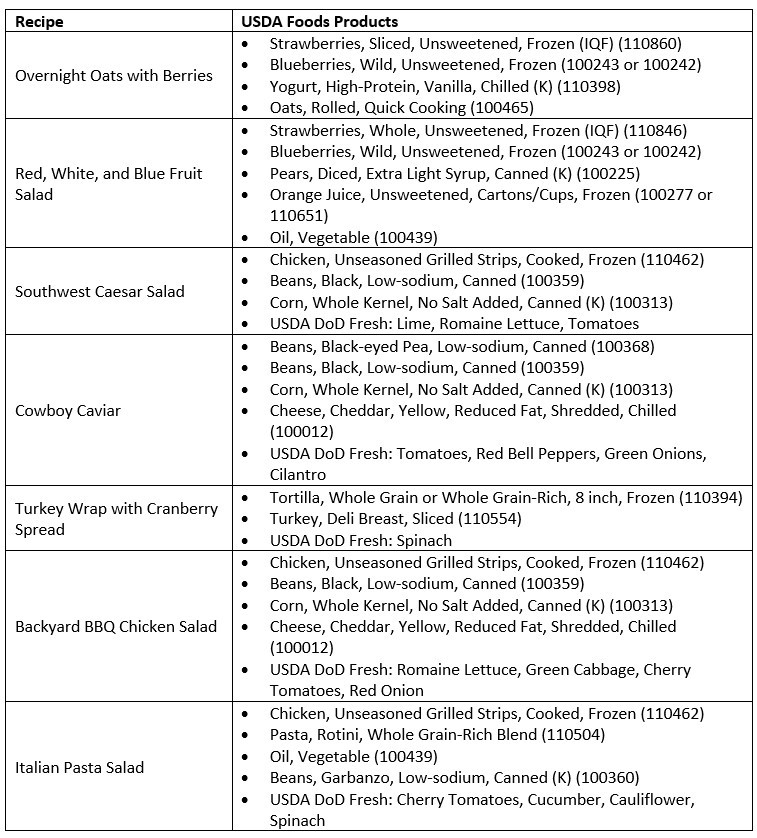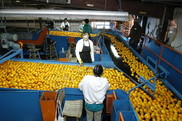
USDA DoD Fresh Fruit and Vegetable Program Update
As school year 2021-2022 ends, the Summer Food Service Program (SFSP) begins, and school year 2022-2023 quickly approaches we want to share some updates about USDA DoD Fresh.
A new long-term contract for USDA DoD Fresh school customers in Vermont was awarded on May 12. The new vendor is Upper Valley Produce, located in White River Junction, VT. Orders will begin the week of July 11, for deliveries the week of July 18. On April 19, a long-term contract was awarded to Seashore Fruit & Produce Company, located in Vineland, NJ for school customers in Delaware, Maryland, and Washington, D.C. Orders with Seashore will begin the week of June 20, for deliveries the week of June 27. As a reminder, the delivery period for these contracts is 6:00am – 2:30pm and the order minimum is $150.00. Across the supply chain there continues to be transportation challenges caused by a shortage of trucks and drivers. Please be understanding if your delivery is late, and know that the vendor will make every effort to notify you in advance. Please make sure the point of contact information in FFAVORS is current as the vendors use this information to contact customers. All communication with produce vendors should always include a Defense Logistics Agency (DLA) representative, as DLA administers these contracts.
This summer, 27 States have allocated over $10 million of SFSP dollars to USDA DoD Fresh to provide fresh fruits and vegetables in the SFSP. Last summer 26 States spent over $6.5 million on fresh produce for SFSP.
As a result of the COVID-19 pandemic, many states had school food authorities (SFAs) that opted to provide meals under the SFSP, using the Nationwide Waiver to Allow Summer Food Service Program and Seamless Summer Option Operations through School Year 2020-2021 Waiver Extension. The meals served under the SFSP waiver are not counted in a State's USDA Foods National School Lunch Program entitlement calculation. SDAs with SFAs that opted to serve meals under the SFSP waiver received significantly higher SFSP dollars to support operations for the past 2 years.
In addition, with funding made available through USDA’s Commodity Credit Corporation (CCC), USDA has provided $300 million for USDA Foods, including USDA DoD Fresh for States to distribute to schools to offset the impact of disruptions to their normal supply chains. Twenty-seven States allocated over $83 million of CCC funds to USDA DoD Fresh for schools to use to order fresh fruits and vegetables for the period of July 1- September 30, 2022. Three states, Arizona, Hawaii and Ohio allocated 100% of their CCC funds to USDA DoD Fresh.
|

Whole Grains
On February 7, 2022, USDA announced it was finalizing its November 25, 2020 proposed rule regarding child nutrition meal pattern requirements. This final rule, entitled Child Nutrition Programs: Transitional Standards for Milk, Whole Grains and Sodium, will establish transitional standards to support the continued response and recovery from the pandemic, as well as update the meal pattern standards to more comprehensively reflect the Dietary Guidelines for Americans, 2020-2025. As a part of this final transitional rule, for SY 2022-2023 and SY 2023-2024, at least 80 percent of the grains served in the school lunch and breakfast menus must be whole grain-rich (i.e. containing at least 50 percent whole grains). USDA continues work on proposed long-term school nutrition standards based on the Dietary Guidelines for Americans, 2020-2025 and feedback from partners.
USDA Foods in Schools supports domestic nutrition programs and American agricultural producers through purchases of domestic agricultural products for use in schools and institutions. USDA Foods in Schools supports this new rulemaking by offering fifteen whole grain or whole grain-rich foods to be used in school lunch and breakfast menus.
The following Whole Grain or Whole Grain-Rich items are available for direct delivery to the School Food Authority (SFA):
- Cereal, Oat Circles, Bowls (111100)
- Flour, 100% White Whole Wheat, 8/5 lb bag (110857)
- Flour, White Whole Wheat/Enriched 60/40 Blend, 8/5 lb bag (110211)
- Flour, White Whole Wheat/Enriched 60/40 Blend, 25 lb bag (110208)
- Oats, Rolled, Quick Cooking (100465)
- Pancakes, Whole Grain or Whole Grain-Rich, Frozen (110393)
- Pasta, Macaroni, Whole Grain-Rich Blend (110501)
- Pasta, Penne, Whole Grain-Rich Blend (110520)
- Pasta, Rotini, Whole Grain-Rich Blend (110504)
- Pasta, Spaghetti, Whole Grain-Rich Blend (110506)
- Rice, Brown, Long Grain, Parboiled, 25 lb bag (101031)
- Rice, Brown, Long Grain, Parboiled, 24/2 lb bag (100500)
- Tortillas, Whole Grain or Whole Grain-Rich, 8 inch, Frozen (110394)
In addition, the following Whole Grain or Whole Grain-Rich items are available in bulk form for the SFA to order to be diverted to processors. SFAs may then contract with the processor for a variety of end products using the bulk ingredients, including pizza and muffins:
- Flour, 100% White Whole Wheat, 50 lb bag (110855)
- Flour, 100% Whole Wheat, 50 lb bag (100409)
|
USDA Foods for Grab & Go Menu Items
USDA Foods products are minimally seasoned and processed and can be customized to meet the diverse menu needs of school districts across the country. Chicken, cheese, beans, and frozen and canned fruit are just a few examples of products that can serve as base ingredients to create Grab & Go dishes. The variety and versatility of USDA Foods products allows schools to develop their menus based on their needs for portable and appealing menu options, while still meeting the required nutrition standards.
Check out just a few of the many USDA Standardized Recipes from the Institute of Child Nutrition’s Grab & Go Recipes that utilize USDA Foods as ingredients.
 For the fresh fruits and vegetables found in these recipes, check out the offerings available for weekly delivery through the USDA DoD Fresh Fruit and Vegetable Program.
What Grab & Go dishes are you cooking up with your USDA Foods? Feel free to share with us at USDAFoods@usda.gov.

Value Pass Through Methods for USDA Foods Processing
State Distributing Agencies (SDA) and school food authorities (SFAs) may choose to divert USDA Foods to an approved National Processor in order to purchase end products at a reduced cost. The cost of the end product is reduced by the value of the USDA Foods contained in the end product. There are four methods of end product sales, also known as value pass through systems permitted under current regulations, refund or rebate, direct discount, indirect discount also known as net off invoice, and fee for service. An approved value pass through system must be used in order to track the value of the USDA Foods contained in or needed to produce end products and ensure that the SDA or SFA receive the full value of the USDA Foods diverted to processors.
An example helps illustrate this. An SFA diverts USDA Foods, (mozzarella cheese, tomato paste, and flour) to a processor to make pizza. The value of the USDA Foods used to make the pizzas is determined by multiplying the USDA established price per pound by the quantity of USDA Foods contained in or needed to produce each finished case of end product. This price is listed in the FNS approved Summary End Product Data Schedules (SEPDS) and is referred to as the contract value.
In this example, the value pass through system used is indirect discount, known as net off invoice (NOI). A commercial distributor is always involved under this system. The contract value of USDA Foods contained in the end product, a 30-pound case of “Double Cheese Pizza” = $17.17
USDA Foods Mozzarella Cheese 8 lbs. x $1.8467 = $14.77
USDA Foods Tomato Taste 1.38 lbs. x $0.4776 = $.66
USDA Foods Flour 8.37 lbs. x $2.075 = $1.74
- The SFA contracted with a distributor to deliver the “Double Cheese Pizza."
- The commercial price of the “Double Cheese Pizza” is $40.00/case
- The commercial price is reduced by the value of USDA Foods/case - $17.17/case
- Plus, add the distributor’s fixed fee for storage and delivery $3.00 /case
- The price the SFA pays using NOI for the “Double Cheese Pizza” is $25.83/case.
Product sales under this system begin as commercial sales and the products being sold are commercial products. An SDA or SFA procures commercial products from a distributor and the distributor procures those products from a processor. The distributor pays the processor at the commercial price. If the eligible SDA or SFA to which the product is being sold has the necessary USDA Foods inventory with the processor, the sale is converted from a commercial sale to an NOI sale. After the NOI sale is confirmed, the processor compensates the distributor for the discount provided for the value of the USDA Foods in its sale of end products to an eligible recipient. The processor may not draw down inventory (i.e., transfer title to recipient agency) until documentation is provided by the distributor that shows a sale to an eligible recipient with adequate USDA Foods inventory. This documentation may be a sales velocity report or other documentation acceptable to the processor that identifies the end product that was sold and the eligible recipient that bought the product.
|
USDA Foods in Schools Supply Chain Webinar Series
USDA FNS Food Distribution Division Staff hosted a webinar on March 31, 2022 titled: Understanding the Storage and Distribution of USDA Foods in Schools. The National Office discussed information that should be included on inventory reports for quick action to keep distribution costs reasonable and ensure USDA Foods are efficiently delivered to schools. Learn about the solicitation requirements with commercial storage facilities and best practices for inventory management. We also discussed ordering best practices, monitoring USDA Foods orders, and how to request destination changes. The webinar recording can be viewed here.
Next month, on June 30th, 2022 from 2:00-3:30pm EDT, we'll be holding the next webinar in the series, Understanding the USDA Foods Processing Program: Tips on How to Efficiently and Effectively Utilize USDA Foods Diverted to Processors. This webinar will provide an overview of the USDA Foods Processing program and share some tips on how effectively manage USDA Foods diverted to processors. We hope to see you there!

American Commodity Distribution Association (ACDA) Annual National Conference Round-Up
It was great to see so many partners at the American Commodity Distribution Association (ACDA) Annual Conference in April. USDA presented a variety of program updates through the USDA General Session and breakout sessions. We also held meetings with stakeholders to hear about concerns on the ground and brainstorm possible solutions. USDA is actively working with the supplier community to provide consistent food supplies to schools, and we continue to provide support to address issues that may arise. USDA is always happy to hear additional feedback from our partner agencies, so please reach out to your State agency or our general mailbox at USDAFoods@usda.gov with questions or comments.
|

School Nutrition Association (SNA) Annual National Conference on July 10-12
USDA is looking forward to seeing many State, school district, and industry partners at the School Nutrition Association (SNA) Annual National Conference July 10-12. We will be hosting a USDA Foods booth, so be sure to stop by #212 on the exhibit floor to talk to staff, share your thoughts, and get your USDA Foods questions answered! We will also be sharing information for industry partners about our requirement to submit vendor-specific information for USDA Foods products through GS1. Stop by the session on Tuesday from 8:00-9:00 a.m. to hear more about this exciting initiative to provide nutrition, allergen, ingredient, and Kosher/Halal certification information to school districts using USDA Foods products.
|
USDA will be participating in these upcoming meetings in 2022:
We look forward to meeting you and hope to see you there!
|